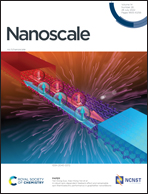Strain engineering and the hidden role of magnetism in monolayer VTe2†
Abstract
Two-dimensional transition-metal dichalcogenides have attracted great attention recently. Motivated by a recent study of crystalline bulk VTe2, we theoretically investigated the spin–charge–lattice interplay in monolayer VTe2. To understand the controversial experimental reports on several different charge density wave ground states, we paid special attention to the ‘hidden’ role of antiferromagnetism as its direct experimental detection may be challenging. Our first-principles calculations show that the 4 × 1 charge density wave and the corresponding lattice deformation are accompanied by the ‘double-stripe’ antiferromagnetic spin order in its ground state. This phase has not only the lowest total energy but also dynamic phonon stability, which supports a group of previous experiments. Interestingly enough, this ground state is stabilized only by assuming the underlying spin order. By noticing this intriguing and previously unknown interplay between magnetism and other degrees of freedom, we further suggest a possible strain engineering. By applying tensile strain, monolayer VTe2 exhibits a phase transition first to a different charge density wave phase and then eventually to a ferromagnetically ordered one.



 Please wait while we load your content...
Please wait while we load your content...